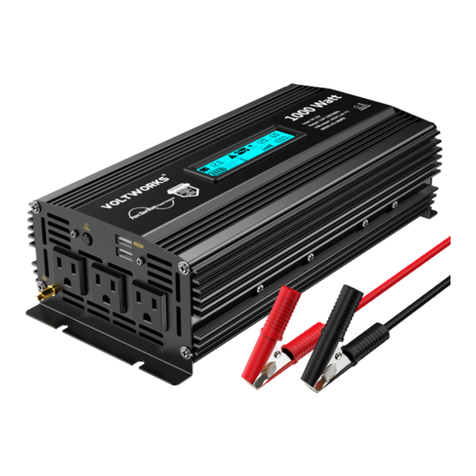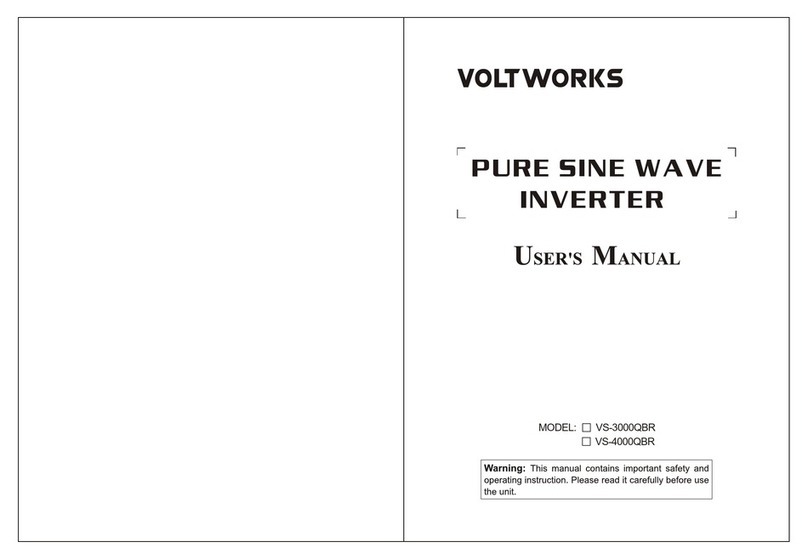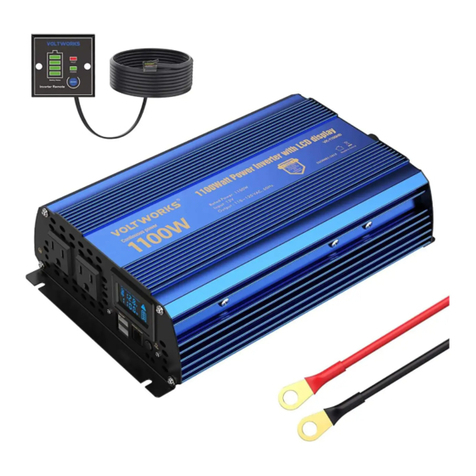
8. 9.
1.LO: Low voltage protection
2. HI: High voltage protection
3. OL: Overload or short-circuit protection
4. OH: overheat protection.
K. PROTECTIONS IN THE INVERTER
1. Input under-voltage alarm: When the input DC voltage is lower than 9.8V (19.6V), the
buzzer will whistle intermittently to remind that the inverter will go into the under
voltage protection.
2. Under voltage protection: The inverter will automatically shut down when the input DC
voltage is lower than 9.5V(19V). The buzzer will whistle continuously and the green
light is off, red light is on. Please turn off the inverter and use it after recharging the
battery.
3. Over voltage protection: The inverter will automatically shut down when the input DC
voltage is higher than 16V(32V). The buzzer will whistle continuously and the green
light is off, red light is on. Please turn off the inverter and adjust the input voltage to the
admissible range.
4. Overload protection: The inverter will automatically shut down when the load is higher
than the rated power. The buzzer will whistle continuously. Turn off the inverter and
resume to normal operation after taking away the excessive load.
5. Short-circuit protection: The AC output will be automatically shut down when short
circuited. It will automatically reset after the problem is solved.
6. Thermal protection: The unit will get hot during operation. If the temperature is higher
than 149°F, the inverter will automatically shut down. Then the buzzer will whistle
continuously and the green light is off, red light is on. Please turn off the inverter, and
continue using it after the temperature goes back to normal naturally. Meanwhile find
out the factors causing the fault, such as ventilation, ambient temperature, vent, load
power etc. It can avoid similar things from happening again.
NOTE: The numbers in the parenthesis are for 24V models. In the case of over
voltage, under voltage and thermal protection, the inverter will shut down. When
the inverter is in the OFF position, the inverter doesn't consume battery current.
L. QUICK KNOWLEDGE ABOUT INVERTER
! Ensure Your Battery Size Is Big Enough And Voltage Is Correct.
A. CORRECTLY CONNECTING THE INVERTER FOR FIRST USE.
1) Secure the provided Negative (black) DC cable connect to the Negative (-) bolt on the
inverter, and the other end to the Negative (-) post on the battery.
2) Secure the provided Positive (Red) DC cable to the Positive (+) bolt on the inverter, and
the other end to the Positive (+) post on the battery.
3) The nuts of the connection posts must be tightened to ensure well connected.
4) Press the power switch for one second, because it is a long press type switch.
120
WARNING: REVERSE CONNECTED THE CABLES WILL DAMAGE THE INVERTER
AND AVOID YOUR WARRANTY!
● Reduce the load power, or turn on the
appliance first, then turn on the inverter.
● Choose a bigger inverter
● Change a bigger battery and ensure fully
charged.
No output voltage,
buzzer whistles
continuously
Problem Reason Solutions
Low Input DC Voltage
High Input DC Voltage
Overload
Over temperature
● Do not use it when the battery is charging
● Check the rated voltage of the battery and
make sure that it is in the allowable range
ofthe input voltage.
Reduce the load power
● Cut off the load and let it cool naturally for
10 to 30 minutes.
● Restart it after it resumes to normal
temperature. Reduce the load. avoid
blocking the vent and improve the
ventilation condition.
No AC outputvoltage? 1.The power switch is off.
2.Poor contact with battery.
● Press the power switch for 1-2 second to
turn it on. it is a long press type switch
●Check the cables and make sure they are
tightly connected.
Output voltagebelow
100 V AC?
“True RMS”voltage meter is
required to properly measure
outputvoltage of modified
wave inverter
Cannot drive theload?
Tester indicated
"Open Ground"?
This is because it is not connected
to a"true Earth ground ", meaning
it is not connected to a metal rod
stuck in theEarth. it would be
impossible to do so in a boat or car
while moving. The powerinverter
DOES NOT and cannot create a
true Earth ground on its own.
● Test output voltage with a True RMS meter
● Try to maintain the input voltage in the
range of rated power
● Change the battery of the meter then test
again.
1.Load power is too large. Or the
actualpower of the appliance
exceedsnominal power.
2.The starting power is larger than
ratedpower (especially for
appliances withmotor)
3.Battery is too small.
● Don't need the tester to do the Grounding
Test.
● Refer to the manual to do the Grounding
Starting alarm ?
The main reason is that ths
instantaneous current is too large,
which leads to the detection of low
voltage and trigger under-voltage
alarm.
Please restart the inverter several
times.
Got 40V or so while
testing inverter's
ground wire and
zero line?
This voltage has no meaning,
zero line can be ground.
This is normal, there is no current
leakage.
Low Input DC Voltage
If the unit still doesn't work normally after using all the methods above, it maybe the
internal faults of the circuit. Please contact us: usvoltworks@gmail.com
B. TROUBLESHOOTING TIPS
If the inverter still doesn't work after trying above measures, there may
be some faults in the circuit. Please return it to the supplier for
maintenance.
L. FAILURE GUIDELINES
No output voltage,
buzzer sounds
continuously
Incorrect output
voltage
Cannot drive the
load
1. Do not use when the battery is charging.
2. Check the rated voltage of the battery
and make sure that it is in the allowable
range of the input voltage.
1. Turn on the power switch.
2. Check the cables and make sure they
are tightly connected.
1. Use a true RMS multimeter to measure,
such as model FLUKE 177/179.
2. Try to maintain the input voltage in the
range of rated power
3. Change the battery of multimeter then
test again.
Reduce the load power, or turn on the
appliance first, then turn on the inverter.
1. The switch is off.
2. The battery lead
isn't connected well
1. RMS Multimeter
measurement error
2. The battery power
of RMS Multimeter
is low.
3. The input voltage
is too high or too low.
1. Load power is too
large, or the actual
power of the
appliance exceeds
nominal power.
2. The starting power
is larger than rated
power (such as
motor).
The internal inverter soft-start circuit will
buffer starting the appliance.
Cut off the load and let it cool naturally for
10 to 30 minutes. Restart it after it resumes
to normal temperature. The load power is
too large, reduce the total load power to the
range of rated power. Avoid blocking the
vent and improve the ventilation condition.
Reduce the ambient temperature.
No output voltage
Low input DC voltage
High input DC
voltage
Overload
Over temperature
Recharge or replace the battery
Reduce the load power.



























